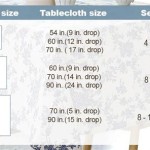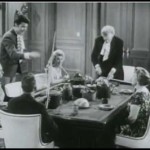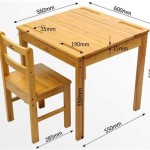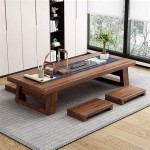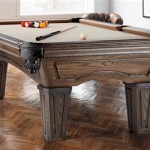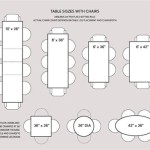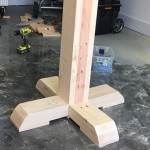West Elm Enamel Nesting Tables: A Comprehensive Overview
West Elm enamel nesting tables represent a stylish and functional addition to contemporary living spaces. These tables, known for their durable construction and versatile design, offer a pragmatic solution for those seeking flexible furniture options. This article delves into the various aspects of West Elm enamel nesting tables, encompassing their design features, materials, functionality, care instructions, and potential applications within a home environment.
Nesting tables, in general, are sets of tables that decrease in size, allowing them to be stored one underneath the other when not in use. This design maximizes space efficiency, making them particularly suitable for smaller apartments, living rooms, or any area where adaptable furniture is desired. West Elm's interpretation of this classic design incorporates a layer of enamel, adding a durable and aesthetically pleasing finish that differentiates them from simpler nesting table alternatives.
The popularity of these tables stems from their ability to serve multiple purposes. They can act as side tables for drinks and snacks during gatherings, individual work surfaces for laptops or books, or decorative displays for plants and other objects. The nested configuration allows for quick deployment and storage as needed, contributing to a clutter-free and organized living space.
Design and Aesthetics of West Elm Enamel Nesting Tables
West Elm offers various designs within their enamel nesting table collection. These designs vary in shape, color, and overall style, catering to a broad spectrum of aesthetic preferences. Common shapes include round, square, and rectangular tables, each offering a distinct visual appeal. The choice between these shapes often depends on the existing furniture and the desired flow within the room.
The color palette of the enamel finish is another crucial design element. West Elm typically offers a range of colors, from neutral tones like white, gray, and black to more vibrant hues that can add a pop of color to a room. The specific color options can vary depending on the season and current design trends.
The enamel finish itself is a key component of the table's aesthetic. Enamel is a hard, glossy substance applied to a metal base, providing a smooth and durable surface. This finish not only enhances the table's appearance but also contributes to its resistance to scratches, stains, and other forms of wear and tear. The reflective quality of enamel can also brighten a room, adding a touch of sophistication.
Beyond the shape and color, the design also incorporates considerations for the overall profile of the tables. Some designs feature slender legs for a minimalist look, while others have more substantial bases for added stability and visual weight. The height difference between the nested tables is carefully calibrated to ensure both easy accessibility and convenient storage.
The specific design details, such as the curvature of the edges, the thickness of the enamel layer, and the finish of the metal legs, contribute to the overall aesthetic appeal of the tables. These subtle elements are carefully considered to create a cohesive and visually pleasing product.
Materials and Construction of West Elm Enamel Nesting Tables
The durability and longevity of West Elm enamel nesting tables are directly linked to the quality of the materials used in their construction. Typically, the base of the tables is constructed from a sturdy metal, such as iron or steel. This metal frame provides the structural support necessary to withstand regular use and weight.
The enamel coating is applied to the metal surface through a process that involves fusing powdered glass to the metal at high temperatures. This process creates a smooth, durable, and non-porous finish that is resistant to scratches, stains, and heat. The thickness of the enamel layer is a crucial factor in its durability; a thicker layer generally provides greater protection against damage.
The legs of the tables are often made from the same metal as the base, ensuring a consistent aesthetic and structural integrity. The legs may be finished with a powder coating or other protective treatment to prevent rust and corrosion. The design of the legs can also influence the stability of the tables; wider legs or a more robust design can provide greater support.
West Elm often emphasizes sustainable sourcing of materials in its furniture production. While the specific materials used in the enamel nesting tables may vary depending on the model and year of production, the company generally adheres to responsible sourcing practices.
The joining methods used to connect the various components of the table are also critical to its overall strength and stability. Welding is a common technique used to securely attach the legs to the base. High-quality welding ensures a strong and durable connection that can withstand the stresses of regular use.
Functionality and Versatility in the Home
The primary advantage of West Elm enamel nesting tables lies in their adaptability. These tables can be readily arranged to meet the evolving needs of a living space. When entertaining guests, the tables can be individually deployed to provide ample surface area for drinks, snacks, and other items. When not in use, they can be neatly nested to save space.
In a living room setting, these tables can serve as side tables for sofas and armchairs, providing a convenient spot to place lamps, books, or remote controls. They can also be used as temporary workstations for laptops or tablets, offering a flexible alternative to a traditional desk. Their mobility allows them to be easily repositioned to suit different tasks and activities.
Beyond the living room, these tables can also be used in other areas of the home. In a bedroom, they can serve as nightstands, providing a surface for lamps, books, and other bedside essentials. In a home office, they can be used as temporary work surfaces or storage solutions. Their compact size and versatile design make them suitable for a wide range of applications.
The height difference between the nested tables is carefully designed to ensure ease of use. The taller table can be used as a primary surface, while the shorter tables can be used as secondary surfaces or for storage. This height variation adds to the functionality of the tables and allows for creative arrangement options.
The enamel finish also contributes to the functionality of the tables. The smooth, non-porous surface is easy to clean and maintain, making it ideal for everyday use. The enamel coating is also resistant to stains and spills, providing protection against accidental damage.
Care and Maintenance of West Elm Enamel Nesting Tables
Proper care and maintenance are essential to preserving the appearance and longevity of West Elm enamel nesting tables. While the enamel finish is durable, it is still susceptible to damage from harsh chemicals, abrasive cleaners, and sharp objects.
For routine cleaning, a soft, damp cloth is typically sufficient to remove dust, dirt, and spills. Avoid using abrasive cleaners or scouring pads, as these can scratch the enamel surface. Mild soap and water can be used for more stubborn stains, but it is important to rinse the surface thoroughly and dry it with a soft cloth.
To prevent scratches, avoid placing sharp objects directly on the enamel surface. Use coasters and placemats to protect the tables from scratches and spills. Be careful when moving the tables to avoid bumping them into other furniture or walls, as this can chip or dent the enamel finish.
Avoid exposing the tables to extreme temperatures or humidity, as this can damage the enamel coating. Do not place hot items directly on the surface, as this can cause the enamel to crack or discolor. Store the tables in a dry, well-ventilated area to prevent rust and corrosion.
If the enamel finish becomes chipped or damaged, it may be possible to repair it with specialized enamel repair kits. Consult with a professional furniture repair technician for guidance on the best repair options. Regular maintenance and careful use will help to keep the West Elm enamel nesting tables looking their best for years to come.
In conclusion, West Elm enamel nesting tables offer a combination of aesthetic appeal, functional versatility, and durable construction. Their design allows for space-saving storage and adaptable use in various settings, making them a practical and stylish choice for modern homes. The durable enamel finish and robust construction ensure longevity with proper care, positioning them as a valuable addition to any living space seeking flexible and elegant furniture solutions.

Ping For Nesting Tables The New York Times

West Elm Enamel Square Nesting Tables Set Of 3 Black Off White 399 Liked On Polyvore Featuring Hom Coffee Table Inspiration Furniture Stylish Side

Enamel Round Nesting Tables Set Of 3 Westelm Side Table Modern Furniture

Nesting Coffee Tables West Elm

Nesting Coffee Tables West Elm

Nesting Coffee Tables West Elm

Jett Side Table 14 West Elm

Mid 20th Century Chinese Black Lacquer And Enamel Nesting Tables Set Of 4 Chairish

Mid 20th Century Chinese Black Lacquer And Enamel Nesting Tables Set Of 4 Chairish

Jett Side Table 14 West Elm


